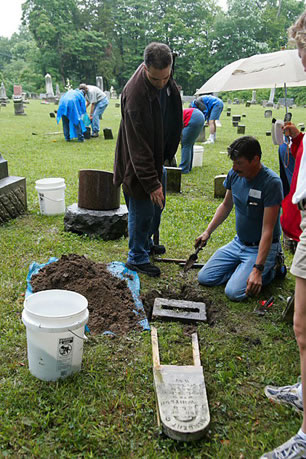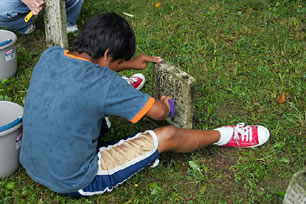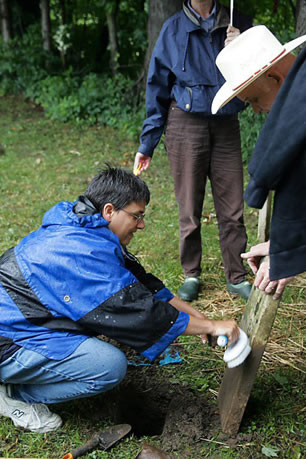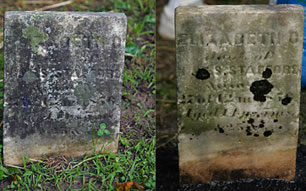
4217 S. Meridian Street • Indianapolis, IN 46217
Phone: 317-788-4554 Fax: 317-788-4570 Email: spotlight@indyweb.net
Founded February 16, 1939
|
From June 16, 2004 issue
"Under the wide and starry sky Dig the grave and let me lie: Glad did I live and gladly die, And I laid me down with a will. This be the verse you grave for me: Here he lies where he long'd to be; Home is the sailor, home from sea, And the hunter home from the hill."
Those lines are borrowed from Robert Louis Stevenson's poem, Requiem. The poem speaks to the honor we give to those sacred places where those we love come to final rest: the cemetery, memorial park, or graveyard. As the only animal on earth that takes such great pains to memorialize the passing of our species, we do it with tenderness and reverence. Yet, as generations pass and the landscape changes, these hallowed grounds are often neglected. The past sites of cherished memories become choked with weeds, vandalized, and sometimes even disappear. Monuments that were carefully chosen and placed to mark the final resting place of loved ones fall, break, and become so deteriorated they are unreadable. In Indiana it is estimated by the Department of Natural Resources that over 100,000 cemeteries exist. Many of that number have been lost to ruin, neglect, vandals, and civilization. This past weekend the Indiana Historical Society, with the assistance of the DNR, offered an opportunity to learn how to care for the pioneer cemeteries that dot the Hoosier landscape. Over 40 interested adults and children from throughout Indiana, Ohio, Michigan, Illinois, and Kentucky gathered at the West Newton Elementary School in southwest Marion County to learn how to care for and restore neglected tombstone and graveyards. The groups focus with the Friends West Newton Cemetery across from the school. The old graveyard, established in 1829, would become a training field for the class. At the outset it was made clear that the restoration of a tombstone should be left to those with knowledge and training. Many an unschooled but well-meaning descendant has caused greater harm to an already aged and deteriorating stone by using the wrong chemicals. Although the class was introduced to the majority of different stones used in Indiana for grave markers (limestone, marble, granite, slate, and sandstone), it became clear that the best cleaner was water. Water and a good scrub brush that has non-metal bristles, with a dash of ammonia sometimes (one part ammonia to four parts water), and a good measure of elbow-grease was the most effective cleaning agent. It was stressed constantly not to use any type of acid or any item containing acid, household cleaner, Clorox, and/or laundry or clothing detergent. These types of cleaners will cause damage. Water was the main cleaning agent. The class was admonished to wet the stones liberally with water before cleaning and to rinse the stones thoroughly with water after cleaning. Once the classroom sessions were over, the group moved across the street to the cemetery for hands-on training between thunderstorms and rain downpours. The students were introduced to John "Walt" Walters, a professional cemetery restorer, for the day's practical exercises. Walters quickly introduced the group to the needs of the cemetery. He noted that there were a number of stones that needed to be straightened, others needed to be re-stacked, while several needed to be re-slotted in their bases. Most of the old stones also needed a good cleaning. Tools were issued and backs were bent to the task. The students took quickly to the various jobs. Small groups formed as shoveling began to prepare to level or straighten the stones while other stones were scrubbed of their seemingly ageless grime. Walters, owner of Graveyard Groomer, a cemetery restoration firm, moved in and out of the small groups advising, demonstrating, and helping to reset a number of the stones. It was immediately obvious that the techniques learned by the group for cleaning, leveling, and restacking the tombstones worked and worked well. The group also became quickly aware that before undertaking any of these common restoration tasks, training was necessary. Not only is training necessary to do the job right, certain legal issues must also be met. One of the most important is that restoration of a cemetery or a single tombstone requires the permission of the owner of the cemetery, regardless of the relationship to those interred. There are a number of laws on the books in Indiana relating to cemeteries. Many are to protect the grave sites from common acts that destroy or disturb the sites. Two of the most frequent are looting and vandalism. Ownership of the cemetery can be a difficult fact to determine. Many of the abandoned cemeteries belong to the respective township trustee who is charged by law to care for the grave site. The township trustees office is a good place to start on the search for ownership. Other old graveyards belong to local churches or to the owner of the farm on which they are found. It is illegal to farm or disturb a cemetery site. Owners of pioneer cemetery sites, however, are not required to provide exceptional care of the property, unlike those graveyards owned by the township trustee. Anyone with questions about grave sites can find out more information by contacting the website of the cosponsor for the cemetery preservation workshop, the DNR 's Division of Historic Preservation and Archaeology at www.in.gov/dnt/historic or 232-1646. The Indiana Historical Society plans to sponsor other such workshops on an annual basis and is a good source to locate preservationist groups throughout the state. Contact John Harris of the IHS at 232-1882 or visit www.indianahistory.org.IHS. Visit Indiana, it's close to home.
|




